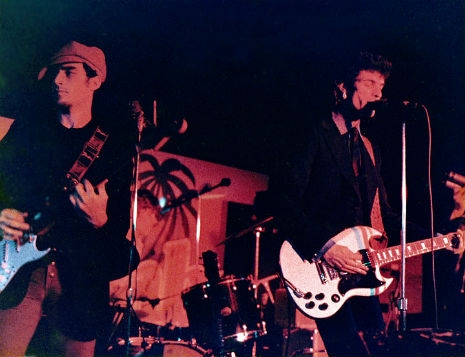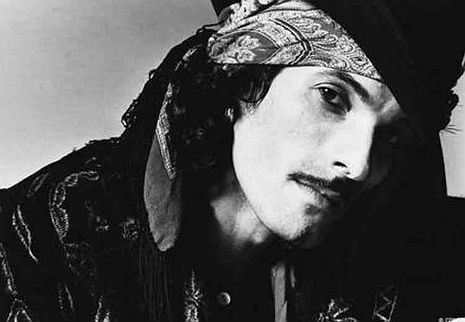
Rocker Willy DeVille died in 2009 at age 58 from pancreatitis and other health problems resulting from his hard-partying lifestyle. Willy’s band Mink Deville was one of the original CBGB’s house bands in New York from 1975-77 and his hipness factor has been well documented. He spent much of his solo career playing in New York, New Orleans, and Europe, where he was incredibly popular. In fact, Willy’s eclectic music was much more well received in France than in the U.S. Undoubtedly his choice to record the Mink DeVille album Le Chat Bleu in Paris and his use of Cajun rhythms and French ballads contributed to his popularity there.
DeVille had a deep-seated hatred for Los Angeles, even though he often recorded at LA studios where cocaine was plentiful, and utilized Latino musicians (including David Hidalgo from Los Lobos) to create his Spanish-Americana roots music. Willy told Sheila René for Rocknet in 1995, “I say it every time I record in L.A. — that I’ll never do it again, and I keep doing it. It’s crazy. I just record and go to the hotel, and never go out, then back to the studio. I hate L.A. It’s the worst. I think they eat their children there. I never saw any kids.”
He also had a mother-hen tendency to worry about other musicians, particularly expat Englishmen, who moved to The City of Angels.
French producer Philippe Rault, based in L.A., recalled a few years before Willy’s death:
“Willy should be worried about his own personal condition than about Englishmen coming to LA. To him, in the pantheon of myth of Willy DeVille’s mind, which is quite large, LA symbolizes Sodom and Gomorrah, the worst of the worst of everything. This is a Connecticut boy who was spooked a few times in LA and never got over it. Basically everything that has to do with LA is bad. To him, going there was a totally decadent situation and somebody was going to go off the deep end. He wasn’t completely wrong in a number of cases, because it has happened along the way. When you look at what David Bowie and John Lennon and all these guys did when they came to LA at one point in their career, it kind of equals downfall and all kinds of wild lifestyles that led to a very difficult moment. But it’s such a stereotype, it’s not even funny. They got over their chemical dependencies but Willy never got over his. My wish for Willy is to get himself back together.”

Rault wrote to me recently:
Let’s look at the real facts of Willy’s career. If failure and addiction warped his vision of Los Angeles, this was mainly a result of his early encounters with two important local music business entities. For starters Capitol Records, which signed Mink de Ville in 1977 and thoroughly sabotaged the group’s career within the framework of a three albums deal, starting with Cabretta. The Capitol executives thought they had signed a ‘punk’ band out of CBGB’s and were expecting to have inked their own Ramones or Television. They probably never listened to the original demos that their scout Ben Edmonds had brought from New York, definitely no punks here. So that was misunderstanding number one. The second album, Return to Magenta, got totally embroiled in a dispute between the band and the company, mostly over money. Le Chat Bleu, the final album recorded in France, was never even released in America and strictly left to the French division of Capitol/EMI, Pathé Marconi to put out. Only Frenchmen with strange musical affinities would appreciate and enjoy that one. And they did, paving the way for Willy’s future European career.
Then there was Jack Nitzche, the musically super talented but also very twisted man Willy described several times as ‘my crazy uncle.’ He was the incarnation of excesses of all types, L.A. style, and consequently brought along a heavy doom and gloom vibe… So associated with the dark side of L.A. that he contributed in a big way to block that celebrated California sun out of Willy’s eyes. Jack produced the first two Mink de Ville albums and Steve Douglas, Jack’s protégé, would produce Le Chat Bleu. Then Jack returned and produced Coup de Grâce in 1981, this time for Atlantic. After that Nitzche kept coming back and knocking at Willy’s door. In 1991 he was due to produce Willy’s first FNAC Music album Backstreets of Desire, but by this time Willy and his wife Lisa had finally seen the light. Willy had started straightening himself out from his heroin addiction and he decided to get away from his crazy uncle.
So much for that complex and ambiguous relationship with the record company and the producer. Career failure and drugs were certainly not the exclusivity of Los Angeles, but symbolically they surely contributed in Willy’s mind to associate the place with distrust and the dark side.
Now let’s see what ended up in the plus column in his association with Los Angeles.
His only ever gold album emerged from Los Angeles in 1992 and launched a whole new phase in his professional life, bringing him artistic and financial success that he had never enjoyed before. Not in America of course, but in Europe. This is the town where a great mariachi band, Nati Cano’s ‘Los Camperos,’ helped Willy create a new rendering of ‘Hey Joe,’ which would ignite his prospects in a big way. I had the privilege to produce that record and even though we did not know we had a hit at the time, we sensed something exciting and unique had happened in the studio. The Mexican touch gave a completely new spin to that hackneyed neo-folk song which had peaked in 1967 with Jimi Hendrix’s take on the story of the man running south of the border to escape the law and the consequences of his crime. Willy totally identified with the ‘bandido’ persona and slid into that character like a hand into a glove. The follow-up video shoot took place in Tijuana, naturally. His first and only gold single, right out of Los Angeles with an all Mexican musicians band, in a studio on Vineland Avenue in North Hollywood.
Also in L.A. I introduced Willy to John Philip Shenale in 1992, in that unhip place known to the world as the San Fernando Valley. This introduction resulted in a long and very creative relationship, which would generate four albums: Big Easy Fantasy, Loup Garou, Crow Jane Alley, and his final album in 2008, Pistola. Phil Shenale did great work with Willy out of his North Hollywood compound, with albums that maintained Willy’s career in Europe in a major way, as he had, in all practicality, given up on his American career. By then Willy did not want to work in the U.S. any longer and the music business here returned the favor. No label wanted to touch him. He was a junky, a has-been, an unreliable entity you did not want to get close to. Only Gary Stewart and Rhino Records’ Forward label attempted to make a go for it in the U.S., without success unfortunately, with the Backstreets of Desire album.
These are the hard facts in Willy’s career and should be taken into consideration as they run contrary to the myth and perspective he liked to propagate of Los Angeles as a ‘plastic’ town, an unholy place to avoid, a locale made for final artistic hell. One can truly argue that in the second phase of his career Los Angeles was quite good to Willy, as he was at last getting his life together again. For a recording career point of view, it turned out to be a very beneficial place for him to work from after all.
One final very positive and important event in Willy’s tumultuous life also happened in Los Angeles. He met his third wife at Capitol Records. Nina Lagerwall, the woman who in the last nine years of his life would stand by him and take care of him in his most difficult moments, until his demise in August 2009.
French guitarist Freddy Koella, who played and recorded with Willy (and shared a love for James Trussart guitars) explained in an e-mail this week why Willy did so much better in France than here:
“[Willy] represented a poetic picture of the American. The Europeans are still fascinated with the U.S. Willy also loved Europe. Its art. Europeans were touched by it. With his different costumes during the years, he was also very entertaining and difficult to grab. A certain mystery. The drug factor also played a role for the fascination. Europeans are also more forgiven about personal battles. He was the beautiful loser. For him to be popular in the U.S, he would have had to get aligned with the norm and work hard. He couldn’t do that. Fighting hard wasn’t his thing.
When he used substances, he was unpredictable. We can consider that a sickness. His team knew it and was ready for that. At times, yes, drugs affected his work.. But physically he had a strong nature, so he was able to manage most of the time. But when he was on his game he was very easy to work with. A very good heart, good sense of humor, a genuinely good person. A friend. It was frustrating at times. But we would forgive him.
He was a very good musician, singer, very instinctive. He had his vision and stuck to it. He loved to emulate his heroes, the old blues guys. He had a very unique voice. You heard his voice for two seconds and you recognized him instantly. That’s the mark of a great artist.”
“Spanish Stroll” at Montreux, 1982